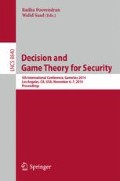Abstract
Security is often investigated in terms of a single goal (e.g., confidentiality), but in practical settings mostly a compound property comprising multiple and often interdependent aspects. Security strategies are behavior profiles that guarantee some performance regardless of how the adversary really behaves (provided that it stays within its action set). While security strategies towards a single goal are easy to compute via Nash-equilibria (or refinements thereof), playing safe towards multiple security goals induces the notion of Pareto-optimal security strategies. These were recently characterized via Nash-equilibria of multi-player games, for which solution algorithms are intricate and may fail for small instances already. Iterative techniques, however, exhibited good stability even for large games. In this work, we thus report on theoretical and practical results how security strategies for multiple (interdependent) goals can be computed via a set of simple transformations and a final application of humble fictitious play.
Access this chapter
Tax calculation will be finalised at checkout
Purchases are for personal use only
Preview
Unable to display preview. Download preview PDF.
References
Acosta Ortega, F., Rafels, C.: Security strategies and equilibria in multiobjective matrix games. Working Papers in Economics 128, Universitat de Barcelona. Espai de Recerca en Economia (2005), http://ideas.repec.org/p/bar/bedcje/2005128.html
Alpcan, T., Başar, T.: Network Security: A Decision and Game Theoretic Approach. Cambridge University Press (2010)
Ashwin Kumar, M., Goundan, P.R., Srinathan, K., Pandu Rangan, C.: On perfectly secure communication over arbitrary networks. In: PODC 2002: Proceedings of the Twenty-First Annual Symposium on Principles of Distributed Computing, pp. 193–202. ACM, New York (2002)
Brandt, F., Fischer, F., Harrenstein, P.: On the rate of convergence of fictitious play. In: Kontogiannis, S., Koutsoupias, E., Spirakis, P.G. (eds.) SAGT 2010. LNCS, vol. 6386, pp. 102–113. Springer, Heidelberg (2010)
Fitzi, M., Franklin, M.K., Garay, J.A., Vardhan, S.H.: Towards optimal and efficient perfectly secure message transmission. In: Vadhan, S.P. (ed.) TCC 2007. LNCS, vol. 4392, pp. 311–322. Springer, Heidelberg (2007)
Ghose, D.: A necessary and sufficient condition for pareto-optimal security strategies in multicriteria matrix games. Journal of Optimization Theory and Applications 68(3), 463–481 (1991)
Ghose, D., Prasad, U.R.: Solution concepts in two-person multicriteria games. Journal of Optimization Theory and Applications 63(2), 167–189 (1989)
Kaminski, H., Perry, M.: A framework for automatic SLA creation. Tech. rep. The University of Western Ontario, Computer Science Publications (2008)
Lozovanu, D., Solomon, D., Zelikovsky, A.: Multiobjective games and determining pareto-nash equilibria. Buletinul Academiei de Stiinte a Republicii Moldova Matematica 3(49), 115–122 (2005), ISSN 1024-7696
McKelvey, R.D., McLennan, A.M., Turocy, T.L.: Gambit: Software tools for game theory, version 0.2007.12.04 (2007), http://gambit.sourceforge.net
Moroni, S., Figueroa, N., Jofre, A., Sahai, A., Chen, Y., Iyer, S.: A game-theoretic framework for creating optimal SLA/contract. Tech. Rep. HPL-2007-126, HP Laboratories Palo Alto (2007)
Rass, S., Schartner, P.: A unified framework for the analysis of availability, reliability and security, with applications to quantum networks. IEEE Transactions on Systems, Man, and Cybernetics – Part C: Applications and Reviews 41(1), 107–119 (2011)
Rass, S.: On game-theoretic network security provisioning. Springer Journal of Network and Systems Management 21(1), 47–64 (2013)
Rass, S., Schartner, P.: Multipath authentication without shared secrets and with applications in quantum networks. In: Proceedings of the International Conference on Security and Management (SAM), July 12-15, vol. 1, pp. 111–115. CSREA Press (2010)
Robinson, J.: An iterative method for solving a game. Annals of Mathematics 54, 296–301 (1951)
Ryu, C., Sharman, R., Rao, H., Upadhyaya, S.: Security protection design for deception and real system regimes: A model and analysis. European Journal of Operational Research 201(2), 545–556 (2010), http://www.sciencedirect.com/science/article/B6VCT-4VXTSK1-2/2/9ffe61e9aa467ce2271adfa338f27842
Sela, A.: Fictitious play in ‘one-against-all’ multi-player games. Economic Theory 14, 635–651 (1999), http://dx.doi.org/10.1007/s001990050345
Voorneveld, M.: Pareto-optimal security strategies as minimax strategies of a standard matrix game. Journal of Optimization Theory and Applications 102(1), 203–210 (1999)
Wang, Y., Desmedt, Y.: Perfectly secure message transmission revisited. IEEE Transactions on Information Theory 54(6), 2582–2595 (2008)
Washburn, A.: A new kind of fictitious play. Tech. rep., Operations Research Department, Naval Postgraduate School, Monterey, California 93943, copyright by John Wiley & Sons, Inc. (2001)
Ying, Z., Hanping, H., Wenxuan, G.: Network security transmission based on bimatrix game theory. Wuhan University Journal of Natural Sciences 11(3), 617–620 (2006)
Yu, W., Liu, K.J.R.: Game theoretic analysis of cooperation stimulation and security in autonomous mobile ad hoc networks. IEEE Transactions on Mobile Computing 6(5), 507–521 (2007)
Author information
Authors and Affiliations
Editor information
Editors and Affiliations
Rights and permissions
Copyright information
© 2014 Springer International Publishing Switzerland
About this paper
Cite this paper
Rass, S., Rainer, B. (2014). Numerical Computation of Multi-goal Security Strategies. In: Poovendran, R., Saad, W. (eds) Decision and Game Theory for Security. GameSec 2014. Lecture Notes in Computer Science, vol 8840. Springer, Cham. https://doi.org/10.1007/978-3-319-12601-2_7
Download citation
DOI: https://doi.org/10.1007/978-3-319-12601-2_7
Publisher Name: Springer, Cham
Print ISBN: 978-3-319-12600-5
Online ISBN: 978-3-319-12601-2
eBook Packages: Computer ScienceComputer Science (R0)

